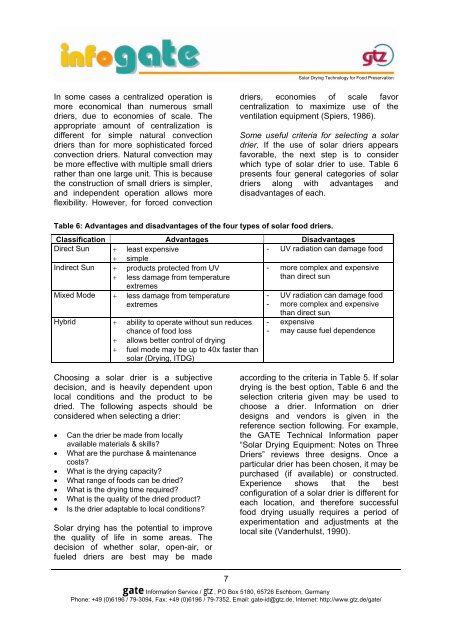Solar Drying Technology for Food Preservation - Pioneer Living ...
Solar Drying Technology for Food Preservation - Pioneer Living ...
Solar Drying Technology for Food Preservation - Pioneer Living ...
You also want an ePaper? Increase the reach of your titles
YUMPU automatically turns print PDFs into web optimized ePapers that Google loves.
In some cases a centralized operation is<br />
more economical than numerous small<br />
driers, due to economies of scale. The<br />
appropriate amount of centralization is<br />
different <strong>for</strong> simple natural convection<br />
driers than <strong>for</strong> more sophisticated <strong>for</strong>ced<br />
convection driers. Natural convection may<br />
be more effective with multiple small driers<br />
rather than one large unit. This is because<br />
the construction of small driers is simpler,<br />
and independent operation allows more<br />
flexibility. However, <strong>for</strong> <strong>for</strong>ced convection<br />
7<br />
<strong>Solar</strong> <strong>Drying</strong> <strong>Technology</strong> <strong>for</strong> <strong>Food</strong> <strong>Preservation</strong><br />
driers, economies of scale favor<br />
centralization to maximize use of the<br />
ventilation equipment (Spiers, 1986).<br />
Some useful criteria <strong>for</strong> selecting a solar<br />
drier. If the use of solar driers appears<br />
favorable, the next step is to consider<br />
which type of solar drier to use. Table 6<br />
presents four general categories of solar<br />
driers along with advantages and<br />
disadvantages of each.<br />
Table 6: Advantages and disadvantages of the four types of solar food driers.<br />
Classification Advantages Disadvantages<br />
Direct Sun + least expensive<br />
- UV radiation can damage food<br />
+ simple<br />
Indirect Sun + products protected from UV<br />
- more complex and expensive<br />
+ less damage from temperature<br />
extremes<br />
than direct sun<br />
Mixed Mode + less damage from temperature - UV radiation can damage food<br />
extremes<br />
- more complex and expensive<br />
than direct sun<br />
Hybrid + ability to operate without sun reduces - expensive<br />
chance of food loss<br />
- may cause fuel dependence<br />
+ allows better control of drying<br />
+ fuel mode may be up to 40x faster than<br />
solar (<strong>Drying</strong>, ITDG)<br />
Choosing a solar drier is a subjective<br />
decision, and is heavily dependent upon<br />
local conditions and the product to be<br />
dried. The following aspects should be<br />
considered when selecting a drier:<br />
• Can the drier be made from locally<br />
available materials & skills?<br />
• What are the purchase & maintenance<br />
costs?<br />
• What is the drying capacity?<br />
• What range of foods can be dried?<br />
• What is the drying time required?<br />
• What is the quality of the dried product?<br />
• Is the drier adaptable to local conditions?<br />
<strong>Solar</strong> drying has the potential to improve<br />
the quality of life in some areas. The<br />
decision of whether solar, open-air, or<br />
fueled driers are best may be made<br />
according to the criteria in Table 5. If solar<br />
drying is the best option, Table 6 and the<br />
selection criteria given may be used to<br />
choose a drier. In<strong>for</strong>mation on drier<br />
designs and vendors is given in the<br />
reference section following. For example,<br />
the GATE Technical In<strong>for</strong>mation paper<br />
“<strong>Solar</strong> <strong>Drying</strong> Equipment: Notes on Three<br />
Driers” reviews three designs. Once a<br />
particular drier has been chosen, it may be<br />
purchased (if available) or constructed.<br />
Experience shows that the best<br />
configuration of a solar drier is different <strong>for</strong><br />
each location, and there<strong>for</strong>e successful<br />
food drying usually requires a period of<br />
experimentation and adjustments at the<br />
local site (Vanderhulst, 1990).<br />
gate In<strong>for</strong>mation Service / gtz, PO Box 5180, 65726 Eschborn, Germany<br />
Phone: +49 (0)6196 / 79-3094, Fax: +49 (0)6196 / 79-7352, Email: gate-id@gtz.de, Internet: http://www.gtz.de/gate/


